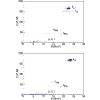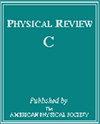Elastic scattering and Li7 production in the Li8+Sn120 reaction
IF 3.4
2区 物理与天体物理
Q1 Physics and Astronomy
引用次数: 0
Abstract
The collision has been investigated at laboratory energies of 21.7 and 25.8 MeV ( MeV). The elastic scattering and the fragment angular and energy distributions from the reaction have been measured. The elastic scattering angular distributions were analyzed by optical model and coupled reaction channels (CRC) calculations considering the coupling with the neutron stripping channel. The effect of the projectile breakup on the elastic scattering distributions has been studied via continuum-discretized coupled-channels (CDCC) calculations. The experimental energy distribution presents characteristics similar to a neutron transfer reaction populating a wide range of excited states in the recoil system, from the ground state up to states above the neutron threshold, with a maximum in the excitation energy predicted by -optimum arguments. These energy distributions, as well as the corresponding angular distributions, are well described using the Ichimura, Austern, and Vincent (IAV) model, which includes the neutron transfer to bound and unbound states of the target nucleus. The total reaction cross sections from the elastic scattering angular distributions and total breakup cross sections have been obtained from the IAV plus CDCC and CRC calculations. A comparison with previous measurements of the scattering on and targets is presented. A dominance of the transfer to bound states over the breakup channel is seen in the present case.

Li8+Sn120 反应中的弹性散射和 Li7 生成
研究了实验室能量为 21.7 和 25.8 MeV(VCBlab=20.5 MeV)的 Li8+Sn120 碰撞。测量了来自 Sn120(Li8,Li7)X 反应的 Li8+Sn120 弹性散射和 Li7 碎片的角度和能量分布。通过光学模型和耦合反应通道(CRC)计算分析了弹性散射的角度分布,并考虑了与中子剥离通道的耦合。通过连续体-离散耦合通道(CDCC)计算研究了弹丸破裂对弹性散射分布的影响。实验中的 Li7 能量分布呈现出类似于中子转移反应的特征,在反冲系统中充斥着从基态到中子阈值以上的各种激发态,其中 Q 最佳论据预测的激发能量为最大值。这些能量分布以及相应的 Li7 角分布都可以用 Ichimura、Austern 和 Vincent(IAV)模型很好地描述,该模型包括中子转移到靶核的结合态和非结合态。通过 IAV 加 CDCC 和 CRC 计算,从弹性散射角度分布得到了总反应截面和总破裂截面。结果与之前对 Be9 和 Ni58 靶的 Li8 散射测量结果进行了比较。在目前的情况下,向束缚态的转移比破裂通道占优势。
本文章由计算机程序翻译,如有差异,请以英文原文为准。
求助全文
约1分钟内获得全文
求助全文
来源期刊

Physical Review C
物理-物理:核物理
CiteScore
5.70
自引率
35.50%
发文量
0
审稿时长
1-2 weeks
期刊介绍:
Physical Review C (PRC) is a leading journal in theoretical and experimental nuclear physics, publishing more than two-thirds of the research literature in the field.
PRC covers experimental and theoretical results in all aspects of nuclear physics, including:
Nucleon-nucleon interaction, few-body systems
Nuclear structure
Nuclear reactions
Relativistic nuclear collisions
Hadronic physics and QCD
Electroweak interaction, symmetries
Nuclear astrophysics
 求助内容:
求助内容: 应助结果提醒方式:
应助结果提醒方式:


